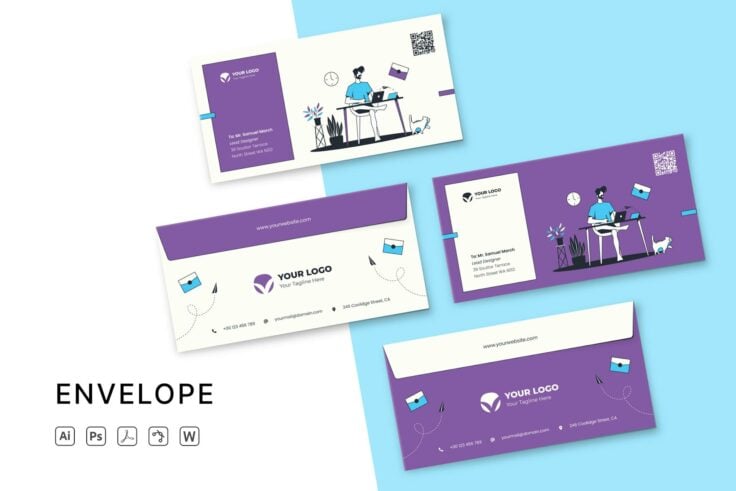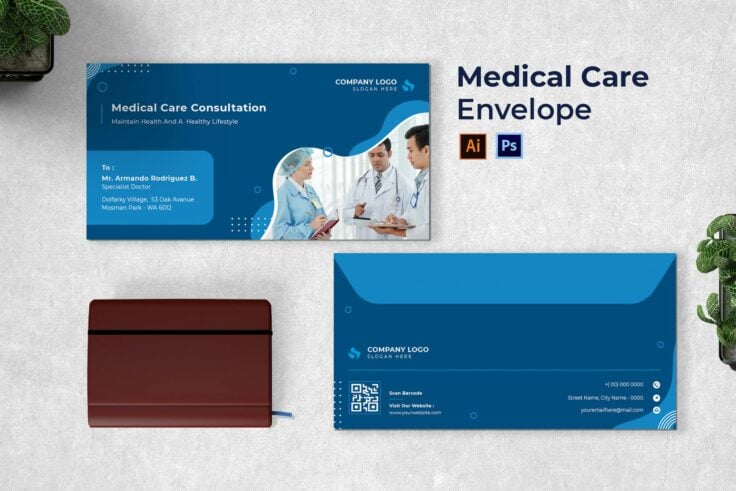15+ Best Envelope Templates
Elevate your correspondence with our envelope print templates, designed to add a professional and personalized touch to your mailings. These templates cater to a variety of styles and purposes, from corporate to personal, ensuring your envelopes stand out with unique designs, branding elements, and attention to detail.

Elegant Envelope Template for Photoshop
Make a lasting professional impression with the Elegant Envelope Template for Photoshop. Crafted with design, architecture, and engineering businesses...

Abstract Envelope Template for Word
The Business Corporate Abstract Colorful stationery Envelope templates present a unique blend of organic classic shape and style. Designed to produce ...

Influencer Studio Envelope Template
The Influencer Studio Envelope Template is a game-changer for any business, corporate agency, or marketing promotions. With its distinctive creative s...

Word Letterhead & Envelope Template Kit
This is a complete stationery kit for Microsoft Word. It includes multiple letterheads and envelops templates in Word, Photoshop, and Illustrator file...

Envelope Template for Agencies
Manage Studio has introduced a new versatile envelope template that is the epitome of creativity and functionality. The template, designed specially f...

BrightSun Corporate Envelope Template
Meet the BrightSun Corporate Envelope Template – a sleek, innovative, and highly versatile communication tool that’s designed to represent...

Stylish Business Envelope Template
Introducing the Stylish Business Envelope Template – perfect for any savvy entrepreneur or business. This Corporate Minimalist, Modern Stationer...

Architecture & Interior Designer Envelope
The Architecture & Interior Designer Envelope PSD Template is a chic, contemporary tool designed primarily for individuals or businesses in archit...

Professional Envelope Template Kit
The Professional Envelope Template Kit is an excellent tool for any business seeking to elevate their corporate correspondence. These templates provid...

Casual Envelope Template for Word
The Creative Business Corporate Organic Leaves Flower Minimalist Style Envelope Stationery Templates offer a fresh take on business correspondence. Th...

Customizable Envelope Stationery Template
Introducing our Creative Corporate Minimalist, Modern Stationery Envelope Templates – a must-have for any business looking to make a lasting imp...

Memphis Style Envelope Templates
Memphis Style Envelope Templates are the epitome of creative sophistication aimed at elevating your corporate communications. This pack of medical cre...

Modern Envelope Stationery Templates
Introducing the effortlessly stylish, Modern Envelope Stationery Templates. These designs are characterized by an earthen pastel color palette, abstra...

Creative Envelope Template
Looking to add some creative flair to your business stationery? The Creative Modern Business PopArt Illustration Minimalist Business Stationery Envelo...

Medical Care Envelope Template
The Medical Care Envelope Template presents a fresh take on conventional stationery with its fully customizable and editable options. Made for modern ...

Colorful & Playful Envelope Template
Unleash your creativity with the Beauty Floral Abstract Organic Flower Shape Creative Modern Business Envelope Stationery Templates. Remarkably easy t...

Minimalist Envelope Templates for Word
Get the perfect representation for your fashion business with our creatively designed Minimalist Envelope Templates. These are meticulously created to...
FAQs About Envelope Templates
What Are Envelope Print Templates?
Envelope Print Templates are pre-designed layouts that serve as a guide for printing designs, addresses, and branding elements onto envelopes. These templates outline the dimensions, bleed areas, and safe zones to ensure that the printed content is correctly positioned and appears as intended on the finished envelope. Envelope Print Templates can vary based on envelope size, style, and intended use, catering to a range of purposes from business correspondence to wedding invitations.
They are essential for ensuring that envelope designs are professional, well-aligned, and compatible with postal service requirements, enhancing the overall presentation of mailed materials.
How Can You Use Envelope Print Templates in Your Design Projects?
Envelope Print Templates can be effectively utilized in various design projects that involve mailed communications. For businesses, these templates can be used to create branded envelopes that reinforce corporate identity through logos, color schemes, and contact information. In personal projects, such as wedding or event invitations, envelope templates help ensure that decorative elements, fonts, and colors are beautifully presented and aligned with the event's theme.
Designers can customize these templates using graphic design software, adding unique designs, return addresses, and recipient address fields that are ready for printing. These customized envelopes add a personal touch to correspondence and can make a significant impact on the recipient's experience.
Are Envelope Print Templates Suitable for All Types of Envelopes?
Envelope Print Templates are available for a wide variety of envelope types and sizes, including standard business envelopes, window envelopes, invitation envelopes, and more specialized formats like A2, A7, C5, and DL. It's important to choose a template that matches the specific type and size of the envelope you plan to use, ensuring that the design elements fit within the printable area and that any windows or special features are accommodated.
For unique or custom envelope sizes, it may be necessary to create a custom template or adjust an existing template to fit the dimensions and layout of the envelope accurately.
How Do You Customize an Envelope Print Template?
Customizing an Envelope Print Template typically involves adding your design elements, such as logos, graphics, and text, within the designated areas of the template. Using graphic design software, designers can import the template and layer their designs on top, paying close attention to the bleed and safe zone guidelines to ensure that all critical elements are visible and well-placed. Customization can also include choosing fonts and colors that align with the branding or theme of the project.
For envelopes that will be used in automated mailing systems, it's also important to ensure that address fields and postage areas are clear and conform to postal service guidelines.
What Are the Best Practices for Using Envelope Print Templates?
Best practices for using Envelope Print Templates include carefully reviewing the template guidelines to understand the bleed areas, safe zones, and any specific requirements related to envelope windows or closure types. When designing, maintain a clear hierarchy of information, especially for business envelopes, to ensure that the recipient's attention is drawn to the most important elements, such as the return address and logo.
It's also advisable to conduct a test print on plain paper to check the alignment and appearance of the design before printing on the actual envelopes. This can help identify any adjustments needed to avoid printing errors. Finally, consider the legibility of fonts and the contrast of colors, especially for envelopes that will be processed by postal services, to ensure that the addresses and postal markings are clear and readable.